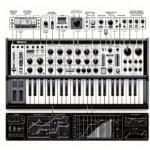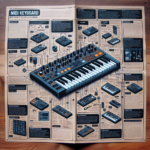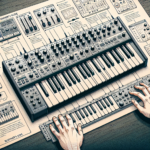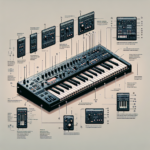Behringer UMX250: Comprehensive Guide to Features, Setup, and Performance

Introduction
The Behringer UMX250 is a versatile MIDI controller designed to meet the needs of both novice and professional musicians. This compact yet powerful device offers a range of features that make it suitable for various applications, from studio production to live performances. Targeted at musicians, producers, and DJs, the UMX250 aims to provide a seamless and intuitive experience for controlling virtual instruments and DAWs (Digital Audio Workstations).
Behringer, a well-known brand in the music industry, has built a reputation for producing high-quality, affordable audio equipment. The UMX250 is no exception, offering a robust set of features at a competitive price point.
Key Features Overview:
- 25 full-size, velocity-sensitive keys
- 8 rotary knobs for real-time control
- 10 assignable switches
- Pitch bend and modulation wheels
- USB and MIDI connectivity
- Battery or USB-powered
- Bundled with energyXT2.5 Compact BEHRINGER Edition music production software
Design and Build Quality
Physical Design
The Behringer UMX250 features a sleek and compact design, making it an ideal choice for musicians with limited space. Measuring approximately 18.5 inches in length and weighing around 4 pounds, the controller is both lightweight and portable. The keys are full-size and velocity-sensitive, providing a realistic playing experience. The body is constructed from durable plastic, which, while not as premium as metal, offers a good balance between weight and sturdiness.
Portability
One of the standout features of the UMX250 is its portability. Its compact size and lightweight design make it easy to transport, whether you’re heading to a gig or moving between studio sessions. The option to power the controller via USB or batteries adds to its portability, allowing you to use it in various settings without worrying about finding a power outlet.
Durability
Despite its plastic construction, the UMX250 is built to withstand regular use. The keys and controls feel solid and responsive, and the overall build quality is impressive for a controller in this price range. While it may not be as rugged as some higher-end models, it should hold up well under normal conditions.
Setup and Configuration
Initial Setup
Setting up the Behringer UMX250 is straightforward. Follow these steps to get started:
- Unbox the controller and connect it to your computer using the provided USB cable.
- Power on the controller by pressing the power button.
- Ensure your computer recognizes the device. Most modern operating systems will automatically detect and install the necessary drivers.
Software Installation
The UMX250 comes bundled with energyXT2.5 Compact BEHRINGER Edition music production software. To install the software:
- Insert the provided CD into your computer’s CD drive or download the software from Behringer’s website.
- Follow the on-screen instructions to complete the installation.
- Once installed, launch the software and configure it to recognize the UMX250 as your MIDI input device.
Compatibility
The Behringer UMX250 is compatible with a wide range of operating systems and DAWs. Supported operating systems include Windows (XP, Vista, 7, 8, 10) and macOS. The controller works seamlessly with popular DAWs such as Ableton Live, FL Studio, Logic Pro, Cubase, and more.
Features and Functionality
Key Features
The UMX250 offers a range of features designed to enhance your music production experience:
- 25 Full-Size Keys: The velocity-sensitive keys provide a responsive and expressive playing experience.
- 8 Rotary Knobs: These knobs can be assigned to control various parameters in your DAW or virtual instruments.
- 10 Assignable Switches: Customize these switches to perform specific functions, such as triggering samples or controlling effects.
- Pitch Bend and Modulation Wheels: Add expressive control to your performances with these essential features.
- USB and MIDI Connectivity: Connect the controller to your computer via USB or use the MIDI output to control external hardware.
Customizability
The UMX250 offers extensive customization options, allowing you to tailor the controller to your specific needs. You can easily assign different functions to the knobs, switches, and wheels using MIDI mapping. This flexibility makes it easy to integrate the controller into your existing setup and workflow.
Unique Functions
One unique feature of the UMX250 is its ability to function as a standalone MIDI controller. This means you can use it to control other MIDI-compatible hardware without needing a computer. Additionally, the controller includes a built-in arpeggiator, which can add rhythmic complexity to your performances.
Integration with DAWs
The UMX250 integrates seamlessly with popular DAWs, providing a smooth and intuitive user experience. For example:
- Ableton Live: Use the controller to trigger clips, control effects, and adjust parameters in real-time.
- FL Studio: Map the knobs and switches to control various aspects of your projects, such as mixer levels and plugin parameters.
- Logic Pro: Take advantage of the controller’s customizable features to streamline your workflow and enhance your creativity.
Advanced Features
The UMX250 includes several advanced features that set it apart from other controllers in its class:
- Aftertouch: This feature allows you to add expressive control to your performances by applying pressure to the keys after they have been struck.
- Arpeggiator: Create complex rhythmic patterns with the built-in arpeggiator, which can be synced to your DAW’s tempo.
- Chord Mode: Play multiple notes with a single key press, making it easy to create rich, layered sounds.
Performance
Latency and Responsiveness
The Behringer UMX250 performs admirably in terms of latency and responsiveness. The keys are sensitive and responsive, providing a natural playing experience. The controller’s low latency ensures that your input is accurately translated into sound, making it suitable for both studio production and live performances.
Real-World Usage
In practical scenarios, the UMX250 excels. Whether you’re using it to control virtual instruments in a studio setting or triggering samples during a live performance, the controller delivers reliable and consistent performance. Its compact size and lightweight design make it easy to transport, while its robust feature set ensures that you have all the tools you need at your fingertips.
User Experience
User feedback for the UMX250 is generally positive. Many users appreciate its affordability, portability, and extensive feature set. Some users have noted that the plastic construction feels less premium than higher-end models, but this is a minor drawback considering the controller’s overall performance and value.
Applications and Use Cases
Beginner vs. Professional Use
The Behringer UMX250 is suitable for both beginners and professionals. Its intuitive design and straightforward setup make it an excellent choice for those new to MIDI controllers, while its advanced features and customizability will appeal to more experienced users.
Studio Use
In a studio environment, the UMX250 shines. Its compact size makes it easy to fit into any setup, while its extensive feature set provides all the tools you need for music production and recording. The controller’s seamless integration with popular DAWs ensures a smooth workflow, allowing you to focus on your creativity.
Live Performance
The UMX250 is also well-suited for live performances. Its portability and battery-powered option make it easy to transport and set up, while its responsive keys and customizable controls provide the flexibility you need for dynamic performances. Whether you’re triggering samples, controlling effects, or playing virtual instruments, the UMX250 delivers reliable performance on stage.
Specific Genres
The UMX250 excels in various genres of music, including EDM, hip-hop, and classical. Its versatile feature set and customizable controls make it easy to adapt to different styles and workflows, ensuring that you have the tools you need to create your desired sound.
Pros and Cons
Pros:
- Affordable price point
- Compact and portable design
- Extensive feature set
- Customizable controls
- Seamless integration with popular DAWs
- Battery or USB-powered
Cons:
- Plastic construction feels less premium
- Limited number of keys (25)
- No aftertouch on all keys
Common Issues and Troubleshooting
Known Issues
Some users have reported issues with the UMX250’s drivers not being recognized by their computer. Additionally, a few users have experienced problems with the controller’s knobs and switches becoming unresponsive over time.
Troubleshooting Tips
- Driver Issues: Ensure that you have the latest drivers installed from Behringer’s website. If the problem persists, try connecting the controller to a different USB port or using a different USB cable.
- Unresponsive Controls: If the knobs or switches become unresponsive, try resetting the controller by powering it off and on again. If the issue continues, contact Behringer’s customer support for further assistance.
Customer Support
Behringer’s customer support is generally well-regarded. The company offers a range of resources on its website, including user manuals, FAQs, and driver downloads. Additionally, Behringer provides email and phone support for more complex issues. Users have reported positive experiences with the company’s customer service, noting that representatives are knowledgeable and responsive.
Comparisons with Similar Controllers
Competitor Comparison
When compared to similar models from other brands, the Behringer UMX250 holds its own. For example, the Akai MPK Mini and the Novation Launchkey Mini are both popular choices in the same price range. While the Akai MPK Mini offers more pads and a built-in arpeggiator, the UMX250 provides more keys and assignable controls. The Novation Launchkey Mini, on the other hand, offers deeper integration with Ableton Live but lacks some of the UMX250’s customizable features.
Feature Comparison
In terms of features, the UMX250 stands out for its extensive customizability and versatile connectivity options. While it may not have as many pads or advanced features as some competitors, its combination of keys, knobs, and switches provides a well-rounded set of controls for various applications.
Conclusion
Summary
The Behringer UMX250 is a versatile and affordable MIDI controller that offers a range of features suitable for both beginners and professionals. Its compact design, extensive customizability, and seamless integration with popular DAWs make it an excellent choice for music production and live performances.
Who Should Buy This?
The UMX250 is ideal for musicians, producers, and DJs looking for a portable and affordable MIDI controller with a robust feature set. Whether you’re just starting or looking to expand your existing setup, the UMX250 provides the tools you need to enhance your creativity and streamline your workflow.
Final Thoughts
Overall, the Behringer UMX250 offers excellent value for its price. While it may have some minor drawbacks, such as its plastic construction and limited number of keys, its extensive features and customizability make it a strong contender in the world of MIDI controllers. If you’re in the market for a versatile and affordable controller, the UMX250 is worth considering.
FAQ
Is the Behringer UMX250 compatible with my DAW?
The UMX250 is compatible with a wide range of DAWs, including Ableton Live, FL Studio, Logic Pro, Cubase, and more. Ensure that you have the latest drivers installed for optimal performance.
Can I use the UMX250 without a computer?
Yes, the UMX250 can function as a standalone MIDI controller, allowing you to control other MIDI-compatible hardware without needing a computer.
Does the UMX250 come with any software?
Yes, the UMX250 comes bundled with energyXT2.5 Compact BEHRINGER Edition music production software. You can also use it with other DAWs and virtual instruments.
How do I customize the controls on the UMX250?
You can customize the controls using MIDI mapping. Most DAWs allow you to assign different functions to the knobs, switches, and wheels on the controller.
What should I do if my UMX250 is not recognized by my computer?
Ensure that you have the latest drivers installed from Behringer’s website. If the problem persists, try connecting the controller to a different USB port or using a different USB cable.
Where to Buy
The Behringer UMX250 is available for purchase from various retailers, including major music equipment stores and online marketplaces. Some of the well-known retailers that carry this product include Guitar Center, Sweetwater, and Amazon. Be sure to check for the best prices and any available promotions before making your purchase.




